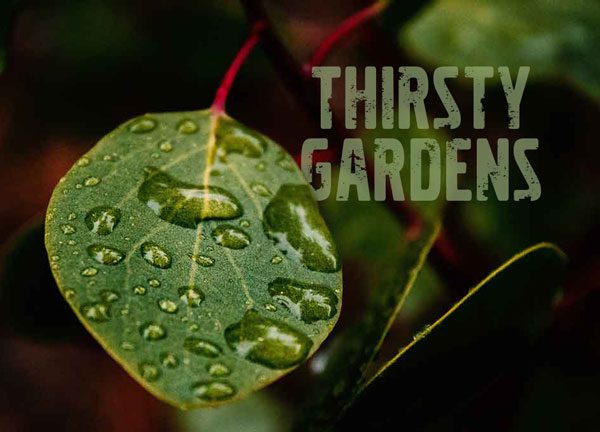The summer is finally near, which means we hopefully have some hot spells on the horizon! And while I love really warm temperatures, I know my gardens get thirsty. We’re on our own well here at my house, so I don’t have any seasonal water restrictions facing people on city water, but I still worry about wasting such a precious natural resource in the garden all summer long.
Watering Tip: The Puddling Method
Some people simply flood their gardens and walk away, but I recently learned a pretty good watering trick at a gardening workshop I was at: it’s called the “puddling method”. When you’re watering your gardens, water enough to create a puddle around the base of the plant; move on to a new area, but count how long it takes for the last puddle you made to absorb. If it absorbs in less than three seconds, the plant needs more water. If the water takes longer than three seconds to disappear, you’ve given that particular plant all it needs. This method not only ensures your plants are properly cared for; it also prevents over-watering and waste.
Water Conservation Tips
There are plenty of ways to be more water-conscious this gardening season; we can all make a difference. Garden Culture Magazine reached out to Friends of the Earth for the following suggestions:
Timing Is Everything

A great water-saving tip is to time your gardening appropriately; the absolute best time to water your plants is in the early morning or at the end of the day. Why? Because it stops the water from immediately evaporating in the day’s sunlight and heat. It’ll also save your leaves from burning in that same heat if you accidentally get water droplets on them. Remember; water onto the soil rather than anywhere else on the plant so the liquid goes straight to the roots where it’s needed.
Catch Rainwater
Here’s a genius idea that’s so incredibly simple: install a rain barrel! Having one saves up to 5,000 litres of water a year, and I believe it. I’ve had my rain barrel for about a week now, and in just one rainfall I had accumulated enough water for all of my current outdoor plants. Here’s a bonus; your plants will actually thank you for rainwater rather than treated tap water. Not only is rainwater slightly acidic (which plants love!), but it’s also 100% soft, likely contains some organic matter after coming across leaves and bird droppings on your roof, and is also a great source of nitrates, the most bioavailable form of nitrogen.
Water Manually
Using a hose or a watering can to quench your garden’s thirst is much better than turning an automatic sprinkler on. In fact, you can cut water use by 33% if you water your plants manually. You may use automatic sprinklers because you don’t have a lot of time to devote to watering your gardens, but keep in mind that spending time caring for your plants is also therapeutic! And we can all use a little garden therapy.
While we’re on the topic of sprinklers, you can also avoid using them on your lawn by adjusting your lawnmower’s cutting height. Longer grass needs less water and doesn’t burn as easily as very short grass, so it looks healthier. Besides, your lawn doesn’t have to look like a putting green; natural is beautiful!
Choose Drought-Tolerant Plants
Some plants get thirsty really easily; others need much less water and don’t require as much maintenance, thriving throughout even the hottest of gardening seasons. Some good choices include lavender, coneflowers, jasmine, marigolds, palms, and conifers. The Royal Horticultural Society has compiled a great list of drought-tolerant plants to choose from. I’ve noticed that with some of these plants, even the occasional rainfall is sufficient for their watering needs. How low-maintenance is that?
Care For Your Soil

The key to retaining moisture in your gardens is looking after your soil. This is where everything starts; healthy gardens begin with healthy soil. Adding compost to the soil improves its structure, meaning it can better retain moisture, oxygen, and essential nutrients.
In addition to adding organic matter to your garden beds, consider placing mulch around your flowers, shrubs, as well as in your hanging baskets to prevent water from evaporating on those glorious, super hot summer days.
Your gardens still have the potential to thrive in dry spells without using an enormous amount of water. Embrace the heat; don’t curse it!